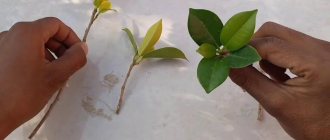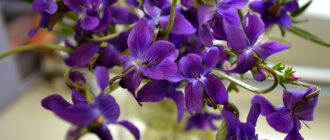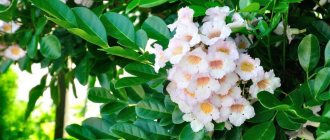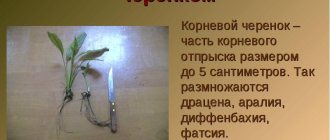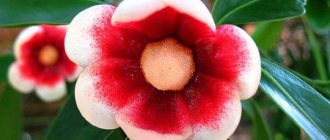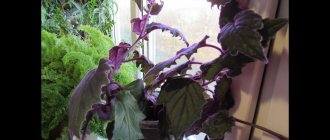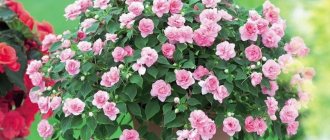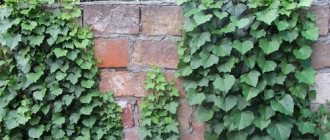We analyze all the important points regarding the propagation of balsam by cuttings
Even a novice florist is at least generally familiar with propagation by cuttings.
Another question is that this method is not suitable for all plants, and when working with others there are rules and prohibitions.
Today we will talk about balsam cuttings. How to do this correctly in order to ultimately get a full-fledged young plant, and we will also learn how to properly care for the plant after planting and what growing problems you may encounter.
Description of the plant
Indoor balsam stands out for its very lush and long-term flowering. Its small, 4-6 cm in diameter, flowers are white, yellow, red, as well as bicolor, and can be simple or double.
The stems are dense, juicy, and have short internodes. The leaves cover the stem abundantly and have a regular shape with a smooth or serrated edge. The color spectrum of the leaves includes various green shades.
Compact bush : dwarf varieties - up to 25 cm, others - about 40 cm.
The geographical homeland of balsam is Africa, Asian countries.
Therefore, in mid-latitudes, planting in open ground is possible only in the warm season. However, more often it is used as a houseplant.
How to propagate at home?
- Seeds. The process is long and painstaking, since balsam seeds do not germinate well, and most of the sprouts die at the initial stage. Their germination requires special conditions. In addition, the result may not please you. After all, most varietal plants do not give their seeds all their characteristics. The result may be a plant with simple flowers.
- Cuttings. The most optimal and effective method. With its help, you can easily and quickly obtain a new balsam plant that matches the characteristics of the donor plant. This method is not suitable only for annual balsam.
General rules for cuttings
Let us consider in detail how to take cuttings and what conditions must be provided for a good result:
- Time. It is recommended to cut garden balsams at the end of summer, but this can be done at any time, except during the period of bud formation and active flowering.
Preparation
How do we prepare planting material:
- Using a sharp knife, cut off a shoot with a tip 8-10 cm in length.
- You need to cut under the leaf, at an angle of 45 degrees.
- There should be no buds or flowers on the cuttings.
- There should be 2-3 internodes on the shoot.
- We remove the lower leaves, leaving 4-6 on the top.
Rooting in water
Impatiens grow roots in water, so you can simply put the cuttings in water. The bare stem should be immersed; the leaves should not touch the water. The glass with cuttings should be placed in a warm, bright place until the roots sprout. After one and a half to two weeks, the seedling is ready for planting in a pot for permanent residence. You can add a stimulant to the water, for example, root.
Landing in the ground
The cuttings with the roots obtained in water are planted in a small pot with fertile soil. Drainage must be placed at the bottom of the pot. Rooting in the ground Another method of rooting is in the ground. This method requires a special soil composition. A mixture of peat, vermiculite and perlite in a ratio of 1:1:2 is recommended.
But you can mix sand and peat in equal proportions. Place soil in a small container and moisten it well. The shoot is placed in the soil for a third of its length. The soil is pressed well against the cutting. The container with the seedling is covered with a plastic bag. It should be kept in a warm, bright place and ventilated periodically.
Transplantation to a permanent place
If everything went well, the cuttings, planted for rooting in the ground, will be ready in a week. In a plastic cup, the roots can be observed through the walls. In any case, after a couple of weeks you can transplant it to a permanent place of residence. Soil, container and drainage have already been discussed.
We talked in more detail about the intricacies of planting and subsequent care in this article.
Growing Balsam from seeds
This method is more labor-intensive and risky. The varietal characteristics of the flower may not be preserved. Initially, double dazzling flowers can turn into simple lights.
Process of obtaining seeds
To collect your seeds from Balsam, its flowers must first be pollinated. To do this, use a clean brush to transfer pollen from one flower to other plants for several days in a row. If a green box is formed, it means pollination was successful. Wait for the seeds to ripen, cut off the capsule and carefully collect the seeds. Do not forget that Balsam is “touchy”; at the slightest shock, the ripe box may not wait for you and scatter the seeds around the room.
The soil
You should prepare the soil in advance, since seedlings are very sensitive to its composition. The soil should be breathable, loose and slightly acidic. Such soil can be purchased at a store for flowering indoor plants. It is only advisable to add one fifth of coarse river sand or vermiculite there.
Recently, it has become popular to plant seeds in peat tablets. Try it, sellers guarantee 100% seed germination and rapid shoot growth. We wrote more about planting in peat tablets in the article: How to use peat tablets for seedlings.
If you decide to prepare the soil for planting Balsam seeds yourself, we recommend the following composition:
- peat soil (2 hours);
- leaf soil (1 hour);
- vermiculite or perlite (1 hour);
- river coarse sand (1 hour).
Such soil will be loose and breathable, it will dry out faster, and weak seedlings will not die from excess moisture.
Container for seed germination
The container for germinating Balsam seeds should be 7–10 cm in height. A plastic container works well for this, but you can use any low, wide bowl or pot. It is advisable that the planting container have a layer of expanded clay at the bottom and drainage holes so that water does not linger in the soil - this will protect the seedlings from rotting of the roots. The day before planting, fill the planting container with substrate and water it with Fitosporin solution - this will improve the soil microflora and protect future shoots from such a serious problem as “blackleg”.
This may be interesting: Homemade (indoor) geranium or pelargonium - care at home
Sowing and caring for seedlings
Seeds are usually sown in early spring. If you plant them in January, you will get flowering two months earlier. Before planting, seeds should be kept for 10–15 minutes in a weak solution of potassium permanganate to prevent rot, and then soaked for a day in warm water to swell.
On the day of planting, place the Balsam seeds on the surface of the substrate at a distance of 2 cm from each other. You should not cover the seeds with soil, if only a little. But bright lighting for their germination is simply necessary (but not direct rays of the sun). Close the container with a lid or cover the plantings with a plastic bag if they are in another container, and place the greenhouse in a warm (20-25 degrees), bright place. For faster seed germination, illuminate the greenhouse with a fluorescent lamp or phytolamp in the evening and on cloudy days.
The first shoots should appear in three weeks. When they appear, you need to carefully pour soil onto the young bare roots and moisten it with a fine spray bottle with warm water. Thanks to proper care, seedlings will quickly grow.
It happens that due to lack of light, seedlings become too elongated. Then, when picking, you should plant the seedlings a little deeper.
When the first true leaves appear, the sprouts can be planted in separate containers (for example, plastic cups). Don’t forget about the drainage holes in the bottoms and expanded clay at the bottom. We recommend keeping the seedlings in cups in the greenhouse for some more time, gradually accustoming them to fresh air.
With sufficient lighting and regular watering, the seedlings become strong and stocky and begin to bush early. To make young bushes branch faster, pinch their tops. The more new shoots grow, the more magnificent the bush will be and the more abundantly it will bloom.
This may be interesting: Strelitzia is a bird of paradise in your home
When the young Balsams have grown noticeably, when their roots have completely entwined the earthen lump in the glass, then transplant them into new permanent pots and wait for the appearance of bright and abundant flowering.
What to do after?
Now let's talk about how to care for a young plant after rooting, what conditions need to be provided to it:
- Impatiens loves sunlight , but soft, not scorching. A south window sill is not suitable for it; it is better to place it in a room close to the window. If there is insufficient consecration, flowering may not occur.
- The temperature for Vanka wet should be normal room temperature. Sudden changes and drafts are not welcome. In winter, a slight decrease is permissible, +12 is the minimum lower limit for balsam.
- Impatiens need abundant watering , the soil must be constantly moist. However, the young plant should be watered carefully at the initial stage. It doesn't use much water yet. You can destroy a flower by flooding it. In winter, watering is reduced, but the soil should still not dry out.
- In summer, the plant can be placed on the street or balcony. The place must be protected from sudden gusts of wind. Staying outdoors has a beneficial effect on the appearance of balsam. The bush becomes more lush and blooms better.
- Like all flowering plants, balsam needs fertilizing with mineral fertilizers. Such care measures will give the plant strength for long and lush flowering. The flower is fed from the beginning of spring until the end of flowering with fertilizer for flowering plants every 10-14 days. After transplanting a young seedling to a permanent place, fertilizers can be applied after 2-3 weeks, as soon as the balsam adapts to the new place. Read here how to water and what to feed this plant for abundant flowering.
When you replant balsam into a new pot, almost the entire volume should be occupied by its roots, only a small distance near the walls of the pot should be filled with new soil. A pot that is too large will result in no flowering this year.
- Plant formation. Too long shoots are pinched to get a more lush bush. Remove excess branches, faded buds, wilted leaves, constantly maintaining the appearance of the balsam in the required quality. Pinching promotes the formation of more flowers. But too large a affected area can stress the plant.
Read about the features of caring for balsam at home here, and you will find all the nuances of growing and propagating at home in this article.
Rules of care
To get healthy young plants, they need proper care. Experienced flower growers recommend following simple rules:
- The air temperature in the room where the flower is grown should not be lower than +15 degrees. This requirement also applies to the winter period. When exposed to too cold air, balsam loses its leaves.
- The plant needs bright, but diffused light. It must be protected from direct sunlight.
- The plant loves moisture, but too much is harmful to the roots, so it is important to ensure good drainage.
- To achieve good flowering, it is better to plant impatiens in a small pot.
- It is better to feed the flower with mineral fertilizers. Excess nitrogen will lead to intensive growth of leaves and stems to the detriment of flowering.
- Periodically pinching the tops of the shoots is done to form a beautiful dense crown.
Propagation of thuja by cuttings in the fall at home
Pruning and replanting
Impatiens should be pruned annually in early spring. At the same time, all elongated shoots are removed, forming a neat bush. It is important to understand how to pinch balsam correctly. If you remove all the extra shoots at once, this will injure the plant. At this time, reduce watering. Such regular pruning will renew the flower.
The crown of the plant and the tops of the shoots must be carefully pinched - this way the bush will be thick and branchy. The plant is replanted in the spring. Over the course of a year, the old substrate is depleted, and the balsam needs to be moved to a larger pot with new soil. A sign that the plant needs a new pot are roots that grow into the drainage holes. This means that the flower has already entwined its roots around the entire earthen lump.
The day before transplanting, the balsam should be watered generously. The flower is carefully removed from the pot and the roots are carefully examined. The old soil is removed from the roots. Damaged or rotten areas are carefully cut off with a sharp knife or scalpel. The cut areas are sprinkled with crushed coal.
Balsam is planted in new soil without deepening the root collar . This must be done quickly so that the roots do not dry out. The soil is lightly compacted near the root. After planting, the flower is watered abundantly and left alone for several days.
Young specimens can be replanted several times a year, using the method of simple transshipment, adding new soil in small quantities. The new pot should be larger. Impatiens need to be planted in the center of the new pot. After planting, the plant is watered and left in the shade for several days.
Possible problems
Unfortunately, sometimes mistakes happen and things don't work out. Let's look at the most common troubles and methods for eliminating them:
Brief description of the flower
In appearance, it is a small bush with erect stems, on which branches with oval leaves, pointed at the base, are densely located. Balsam flowers have irregular shape and texture: there are double and smooth types, solitary or collected in inflorescences. In addition, they have a varied color palette, depending on the type they can be: white, red, pink, orange, coral, or combine two or three colors at the same time. That is why the second name of the home flower is “light”. People also call balsam “Vanka wet” for its love of moisture. In inclement weather, in rain and fog, it really becomes wet - droplets of water, sweet to the taste, form on the sharp edges of its leaves.
In addition to the above, we advise you to read the article about Balsam. It contains information about signs, what it is also called, the characteristics of the plant are given and the most popular varieties are described.
There are several ways to plant balsam: cuttings, seeds, layering. In this article we will consider only one of them, which one - read below. It is worth watering your pet more intensively than other house plants, but you should not allow water to stagnate in the roots! We recommend watering it every one to two days in the summer, and twice a week in the winter.
Watering
Don't skimp on water! Watering is the most important agrotechnical requirement for caring for balsams. I watered my first flower first, like other plants - as the substrate dried. But my balsam somehow quickly wilted, the leaves withered, and the flowers and buds fell off. Fortunately, I quickly realized what the reason was and began to water it more intensively. In summer I water indoor balsam every other day, in winter once every 3 days or 2 times a week. In addition, I began to water it so much that some of the water poured into the pan. I didn’t empty the water from the pan, but the next day it wasn’t there! The ever-thirsty balsam drank during the night what he could not drink during the day.
- Indoor flowers from seeds
In my experience, the balsam flower is best planted in a pot that has a fairly deep tray. You need to water it abundantly, so that some of the water ends up in the pan. And unlike other plants, I do not completely drain this water. On the second day, balsam already absorbs it from below.
If you allow the flower to wilt, try watering it generously. It happens that after a few hours the flower comes to life, and yet such tests greatly weaken the plant. There is no need to allow the substrate to dry out; the earthen ball should be moist. But stagnation of excess water is also dangerous because sciarids - tiny flying midges - will appear in the soil.
Planting balsam from cuttings
This plant is absolutely unpretentious, so it is ideal for beginning gardeners. An excellent method of propagation that preserves 100% varietal characteristics is balsam cuttings. There are several vegetative methods for propagating balsam by cuttings:
Rooting in water
We cut off the top of a healthy bush, approximately 8-10 cm with 2-3 internodes (the branch should not have flowers or buds), then remove the lower leaves and place them in a container with water (do not immerse the leaves in water to avoid rotting). Leave the cuttings in a bright, warm place. In 10-14 days it will give roots. Now it can be planted: a small pot with the following contents is suitable for this - compost, humus and turf soil in equal parts. Also, you should not get carried away with abundant fertilization of the seedling, since in the best case, its leaves will grow, to the detriment of flowering; in the worst case, the flower may die completely. You should also be careful with watering: it is best to water along the edge of the flowerpot or into a tray, excluding direct contact with water on the trunk of the plant, as this is fraught with rotting. If you notice that the flower is withering, the flowers and buds are falling off, then most likely this is a signal of insufficient moisture or high water hardness. For irrigation, use settled water at room temperature. Hard water makes the soil overly alkaline, which leads to various types of diseases. A high concentration of alkali can be determined by seeing limescale deposits on the soil surface. In this case, to resuscitate the plant, you just need to update the top layer of soil.
Rooting in the ground
We select a healthy branch with two or three nodes and, having broken off the lower leaves on it, we ground it by about a third. A substrate consisting of 25% peat, 25% vermiculite and 50% perlite is suitable for this. The use of peat provides nutrition, and a mixture of vermiculite and perlite allows you to qualitatively improve the characteristics of the soil: its looseness and breathability increase; clumping and crust formation on the surface are prevented, which allows roots to develop evenly; in addition, vermiculite prevents overheating or hypothermia of the soil. In order for the cuttings to take root well, you need to ensure that the soil is moist. To improve the saturation of the soil with oxygen, do not forget to loosen the soil occasionally, to a depth of approximately 1 cm. Another subtlety: to speed up the germination of the seedling, you can create a greenhouse for it. To do this, cover the pot with the indoor plant with cellophane or plastic wrap and place it in a warm, bright place. With proper care, the cuttings will take root within a week!
Propagation by seeds
Balsam propagation by seeds at home is carried out using your own seeds and purchased planting material.
You can only use your own seeds if they were collected from the same plant variety. They are harvested when the seed pods become a little transparent.
Ripe seeds are dark in color and will be clearly visible through the walls of the fruit. They are torn off with two fingers in the morning. This method will prevent the boxes from cracking and losing most of the seeds.
The largest seeds are selected for sowing. Stored in a ventilated, dry and shaded place. Germination persists for 5-8 years.
Store-bought seeds are used when growing hybrid varieties. This planting material has a high germination rate. These seeds are often treated with a growth stimulant, which allows them to germinate quickly.
Impatiens flowering in the garden
To get a flowering Balsam bush in May, you need to sow the seeds in early February.
For this purpose, containers for seedlings are prepared from plastic or natural materials. They are filled with a mixture of perlite and peat in a ratio of 1:2. Planting depth 1-2 cm.
After sowing, the top layer of soil is sprayed with clean water from a spray bottle.
The containers are covered with glass or thick cellophane. The temperature is maintained at 20-25 degrees for 10-12 days. During this period, it is important to maintain stable humidity, but waterlogging should not be allowed.
After germination, the container gradually opens. After the sprouts reach two centimeters, they are picked. Balsams are planted in separate pots after each seedling has formed one true leaf.
Propagation by seeds is a very long and painstaking method. Compliance with the technique of growing seedlings of flower plants is mandatory in this case.
When is the best time to take balsam cuttings?
If you want to get a formed flower by summer, then it is best to take cuttings in the spring. By this time, the cuttings will germinate, take root and be ready to flower. It is best to carry out cuttings in March. This is a sunny spring month, when everything in nature comes to life and blooms; our shoot is no exception; bathed in the sun’s rays, it will germinate faster and will not stretch out much. In order for Balsam to continue to please you, it is not enough to simply propagate it; you need to know the conditions of its maintenance and the rules of care, as well as be prepared to deal with its pests and know how to deal with possible diseases.
What is balsam
This cute flower has been around for a long time and is incredibly popular. It can rightfully be considered the most popular plant in the world. Balsam first appeared in Europe in 1596. They love this flower because it is completely unpretentious, blooms almost constantly, and can be propagated quite simply. Among the people, it received many other names, such as: light, evergreen, touch-me-not, and also Vanka-wet.
Branched and quite juicy stems can reach a height of 15–50 centimeters (this depends on the variety). Its fleshy leaves, with wavy edges, are green-reddish, green or bronze in color. Drops of liquid may form at the tips of the leaves, this happens after the humidity rises. That is why people call this plant Vanka-wet.
Impatiens flowers are found in the axils of the leaves. Their color is quite varied. So, you can find varieties with pink, red, white, orange, purple flowers, and they may also have spots or stripes. There are also hybrids with multi-colored leaves and spectacular double flowers. As a rule, their flowers are quite small, but due to their bright color they are very impressive, it is not for nothing that this plant received the name “light”.
After the balsam fades, it produces a green fruit. And then, when it ripens, it becomes a box with seeds inside. If you touch it lightly, it will rupture and the seeds will scatter in different directions at high speed. That’s why it received another name “touch-me-not.”
Flowering of these plants continues almost continuously throughout the year, hence the name “everbloom”.
This flower is grown as an indoor perennial, and is also used to decorate gardens and balconies (annuals).
Thanks to breeders, a large number of varieties and hybrids have appeared. They differ in size, shape, size and color of flowers, as well as leaves.
In order to decorate a balcony or flowerbed, you can use special varieties that can withstand fairly low temperatures. Their flowering begins in spring and continues until frost.
Also, this flower is excellent for rooms where children spend a long time, or rather, nurseries, schools, kindergartens, and so on.
Description and varieties
The genus Impatiens, or impatiens, is represented by annual or perennial herbaceous plants of the genus Impatiens, naturally growing in the tropics of East Africa and India, Ceylon, New Guinea, and temperate regions of Asia.
The family is named touchy-feely due to the fact that the box with ripened seeds bursts with a crash when touched slightly and scatters the seeds far (up to 2 m) around itself.
In Russia, this indoor flower is often called “Ogonyok” for its rich and long-lasting flowering. In addition, for their love of water, the flowers are called “Vanka-wet”. Indoor balsam is one of the most famous undemanding houseplants.
What does the plant look like:
This flower looks like a spherical shrub with a height of 20 centimeters to 2 meters, it directly depends on the species.
- The stalk contains many succulent and translucent branches, on which fleshy leaves grow, with waves along the edges. Painted malachite or reddish. There are types of balsam, the leaves of which have a terry surface.
- flowers surprise the eye with an abundance of alternative colors and shades, from white and pale pink to an exciting reddish. The scarlet variety was called “light”. Delicate flowers with spur-like shoots envelop absolutely the entire plane of the bush during the flowering period.
- The seed pods of such a plant, true impatiens, open when touched and the seeds in the center scatter in all directions.
Varieties and varieties
According to various sources, the number of balsam family reaches from 400 to 550 varieties. Particularly common are the classic varieties, which are spreading bushes with scarlet and snow-white flowers.
Over time, they began to be replaced by various hybrid varieties - they differ in the smallest, densest bushes, with rich flowering, and new colors. Variegated (variegated) plant types belong mainly to New Guinea hybrids. Four options are more common.
- Waller's balsam . The species has several hybrid varieties with similar characteristics. The height of the bush reaches up to half a meter or slightly higher. The shoots are bare, fairly branched, and thick. Thin leaves are attached to long petioles. The flowers are separate, large, and located at the ends of the shoots. The coloring is varied. Terry shapes collide.
- Peters' balsam. A very tall, bushy plant. The shoots are slightly pubescent. The color of the ground part has a bronze tint. The flowers are blood-colored, on high stalks.
- Niamey balsam. Bush up to a meter high, with tall, branching shoots. The leaves are elongated and tightly placed on the stem. The buds on tall stalks are folded in the leaf axils. The flowers are mostly red. There are two-color varieties with the addition of yellowish inclusions.
- New Guinea balsam. Contains a group of perennials of tall and compact forms. The flowers are of different shades, the leaves are quite large.
Caring for balsam at home
Balsam grown at home is not demanding and is very easy to care for. However, if the simple rules of care are violated, then the leaves of this plant at the bottom of the stem will begin to fall off. But not only this can cause leaf shedding. This can happen if the flower has become very old and then it will need to be rejuvenated. However, in any case, the plant will not wither and, moreover, it will also bloom profusely (in most cases).
Illumination
This flower can grow calmly both in good light and in partial shade and even in the shade. But if you want its flowering to be continuous and abundant, then it simply needs bright light (several hours a day will be enough). In the summer months, it is better to remove it from the windowsill located in the southern part of the room, or shade the plant. The best option for placing the plant is a window located in the eastern or western part of the room. In the summer, it can be taken outside or onto the balcony.
Of course, balsams are the best decoration for your garden. But here it is worth considering that they do not need to be planted in sunny places. They feel great in partial shade, and there are a large number of species that grow only in shady places. Only New Guinea hybrids can grow in the sun.
Temperature
There are no special preferences. Normal room temperature will do. In winter, the temperature should not fall below 12⁰ C.
Hydration
Normal air humidity, which is available in residential premises, is quite suitable for them. It is worth considering that excessively low humidity can cause flowers to fall off.
How to water correctly
This plant loves moisture very much. The fact is that it has succulent stems. And if it lacks moisture, then the stems become less elastic and the leaves below fall off.
In the summer, it is necessary to water the balsam abundantly and ensure that the substrate is constantly moistened. In winter, you need to water the flower less, but you must make sure that the earthen lump does not dry out. If there is stagnation of liquid in the pan or the soil is oversaturated with moisture, then rot may appear on the stems and roots.
Top dressing
This flower is fed only in spring and summer a couple of times a month, not more often. Fertilizer for flowering plants is perfect for feeding. If the earth is oversaturated with nitrogen fertilizers, the flowering will not be so abundant, but the balsam will grow actively.
Transfer
An earthen mixture for flowering plants is excellent for this flower. For replanting, select a pot that is only slightly larger in size than the volume of the root system, because if it is very large, flowering will not occur for a long time.
Impatiens that have grown from cuttings do not require replanting. And all because, blooming all spring and summer, in the autumn they become old and not very beautiful, and therefore they must be renewed using cuttings.
What soil to choose
Any loose mixture rich in nutrients is perfect for these flowers.
Reproduction methods
Balsam can be propagated quite simply by cuttings or seeds. The apical shoots are suitable for cuttings, and the seeds can be purchased at any flower shop. Seeds are sown in February or March in a greenhouse or greenhouse. The first shoots will appear in almost a month, provided that the temperature is between 23–25 degrees.
Cuttings should be approximately 8–10 centimeters in length. For rooting, moistened soil mixed with sand is used, or you can also take plain water. They produce roots quite quickly, in just a few days. Then the cuttings are planted in not very large pots and after a couple of months they may well begin to bloom.
Pests and diseases
This plant can attract whiteflies or aphids. Also, if the air is not humidified enough, spider mites may appear. If the damage is significant, then treatment with insecticides cannot be avoided. And when there is an excess of moisture, gray rot forms.
Possible problems and causes
- The plant drops its lower leaves - lack of moisture or heat, presence of pests.
- Withering of leaves is a lack of moisture. If even after watering they continue to wither, then most likely the root system has rotted or there are pests on the plant. Try to re-root the apical shoot.
- Poor flowering - little nutrients or light. Perhaps the plant is planted in a very large pot.
- Elongated shoots - little light or very hot.
- The fall of flowers is a dry earthen ball or excessively low air humidity.
Main nuances
To cut a plant at home, special requirements must be met.
Spring is the best time to carry out balsam cuttings, because the metabolic processes occurring in it accelerate. Cells are actively dividing, forming new ones, and cuttings easily acquire roots.
A week before rooting, balsam is fed with complex fertilizers. From a healthy plant, cut off the tops of young branches with 2-3 internodes 8-10 centimeters long . Ideally, there should be no flowers on the cut shoot, but if there are any, remove them. The leaves located at the bottom of the cuttings are also cut off, and the upper ones are left.
Before rooting, dip the tips of the petioles into a solution of general purpose growth hormone. Experienced gardeners use rooting stimulants. Both improve rooting and accelerate the formation and development of powerful roots. The cuttings are treated with a dry mixture of a growth stimulator with charcoal or kept in a solution diluted in water.
Read also: Copper sulfate use in gardening in autumn grapes
Types of balsam with photos and names
Among the many types of balsam, the following are especially notable for their decorative properties:
Hawker's Impatiens (Impatiens Hawkeri)
It was thanks to him that New Guinea balsam hybrids (Impatiens New Guinea) were born. They have quite large flowers, and the leaves have an elongated shape. Flowering continues all year round. These hybrids tolerate direct sunlight perfectly.
Waller's or Waller's balsam (Impatiens walleriana)
This species is the ancestor of a large number of hybrids. Its leaves are brownish-reddish in color, and the stems are very juicy. It has a lot of flowers and often they completely cover the leaves.




